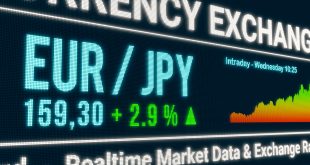The world’s largest economy is grappling with rising inflation levels. Per the latest Labour Department report, the Consumer Price Index (CPI) jumped 8.5% year over year in March, reaching the highest level since December 1981. The reading also surpassed the already high Dow Jones estimate of 8.4%. The high inflation level can set the tone for another interest rate hike soon.
The core inflation index, which excludes volatile components such as food and energy prices, rose 6.5% year over year, marking the hottest reading since August 1982. Energy prices remained a key contributor to the inflation numbers, with a 32% year-over-year increase.
The core personal consumption expenditures (PCE) price index rose 5.4% year over year, witnessing the largest jump in 40 years. The Federal Reserve considers this metric the most dependable inflation indicator. The index was a little shy of the Dow Jones estimate of 5.5%.
Going on, the dual forces constituting the Russia-Ukraine conflict and the surging inflationary levels are weakening the US consumer sentiment levels. The rising commodity prices due to the war crisis are increasing consumers’ struggles. The latest disappointing consumer sentiment final reading for March slipped to the lowest level in about 10 years, highlighting the same.
The University of Michigan’s consumer sentiment index dropped to 59.4 in March from the preliminary reading of 59.7 issued earlier in the month. The metric lagged the expectations of economists who estimated it to remain unchanged.
Notably, the hot inflation data compelled investors to look for alternative investment options that may fare better than cash or bonds in an inflationary environment. Moreover, certain companies with compromised pricing power may take a severe hit amid inflation and future earnings may also look less attractive amid high inflation levels. Against this backdrop, let’s take a look at some ETF trades that can be considered:
Considering the current scenario, gold prices have been rising. The inflationary backdrop in the United States is favorable for gold as the metal is viewed as a hedge against inflation. Commerzbank also predicts 2022 to be a favorable year for gold. The report further mentioned that “in the United States, inflation is currently at a 39-year high of 6.8%, in Germany at more than 5%, the highest level in 29 years, and in the Eurozone at 4.9%, the highest since the start of the monetary union in 1999.”
Going on, the report mentioned that “This means that market participants do not expect inflation to return to the Fed’s 2% inflation target in the medium to long term. Should the higher inflation become entrenched and the central banks fail to react appropriately to it, gold would probably benefit from this as an inflation hedge. According to a study by the World Gold Council, gold stands out with its price performance in phases of high inflation (inflation >5%). Even with inflation rates between 2% and 5%, the performance of gold is still significantly positive.”
Gold Exchange-traded funds, i. e. gold ETFs mostly move in tandem with gold prices. The SPDR Gold Shares GLD and iShares Gold Trust IAU are some of the popular ETFs. GLD and IAU carry a Zacks ETF Rank #3 (Hold) and have a Medium-risk outlook.
Investors can keep track of ETFs that seek to hedge against or benefit from inflation. In this regard, the actively-managed Horizon Kinetics Inflation Beneficiaries ETF INFL is an option that invests in companies expected to benefit from inflation. The Fidelity Stocks for Inflation ETF FCPI can also be considered as it holds companies with attractive valuations, high-quality profiles and positive momentum in industries that generally outperform in inflationary environments.

 Noor Trends News, Technical Analysis, Educational Tools and Recommendations
Noor Trends News, Technical Analysis, Educational Tools and Recommendations




